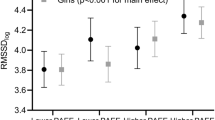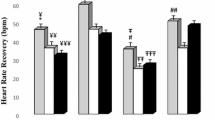Abstract
The heart rate (HR) response to specific physical exercise (ten squats at a maximum speed) in 122 boys and 128 girls who were 4–7 years of age and attended a kindergarten. All children were assigned to health groups 1 or 2. The heart rate was recorded at rest, during exercise, and in a recovery period (5 min) with Polar heart monitors. The intensity of HR debt accumulation (IHRDA) was calculated for each subject from the test results. There was no significant difference in physiological reactions between girls and boys. The exercise duration decreased with age, reflecting more intense test performance. IHRDA, which characterized the specific energy consumption, increased accordingly. A negative pulse phase was observed in some children during the recovery period. An analysis of individual pulse curves identified three variants of the HR response during exercise and the recovery period. The response type was not associated with sex, age, or anthropometric characteristics, but determined the final IHRDA value. Pairwise correlations were observed between anthropometric and functional parameters in the children 4 to 7 years of age. In general, the findings indicate that an individualized approach is important to use when planning physical activity and evaluating the efficiency of physical education in preschool children.


Similar content being viewed by others
REFERENCES
Nikolaidis, P.T., Kintziou, E., Georgoudis, G., et al., The effect of body mass index on acute cardiometabolic responses to graded exercise testing in children: a narrative review, Sports (Basel). 2018, vol. 6, no. 4, p. 103.
Collings, P.J., Westgate, K., Väistö, J., et al., Cross-sectional associations of objectively-measured physical activity and sedentary time with body composition and cardiorespiratory fitness in mid-childhood: the PANIC study, Sports Med., 2017, vol. 47, no. 4, p. 769.
Tuan, S.H., Su, H.T., Chen, Y.J., et al., Ability of preschoolers to achieve maximal exercise and its correlation with oxygen uptake efficiency slope ∼ an observational study by direct cardiopulmonary exercise testing, Medicine (Baltimore), 2018, vol. 97, no. 46. e13296
Korol, V.M., Sonkin, V.D., and Ratushnaya, L.I., Muscular performance and heart rate in adolescents depending on the level of puberty, Teor. Prakt. Fiz. Kul’t., 1985, no. 8, p. 27.
Kornienko, I.A. and Sonkin, V.D., Energy and physiological “cost” of muscular work of children 7—17 years, Fiziol. Chel., 1991, vol. 17, no. 5, p. 130.
Kozlov, A.V., Rosenthal, M.G., and Sonkin, V.D., Correlation between the intensity of pulse longevity accumulation and the rate of blood lactate accumulation in performing limiting cyclic exercises of different duration, Sbornik tezisov IX Rossiyskoy, s mezhdunarodnym uchastiyem, konferentsii po upravleniyu dvizheniyem, posvyashchennoy 95-letiyu so dnya rozhdeniya I.B. Kozlovskoy (Kazan’, 2–4 iyunya, 2022 g.) (Collection of Theses of 9th National Conference with International Participation on Motor Control Dedicated to the 95th Anniversary of I. B. Kozlovskaya (Kazan, June 2−4, 2022)), Baltina T.V. and Tomilovskaya, E.S., Eds., Kazan: Brig, 2022, p. 135.
Fedotova, T.K. and Gorbacheva, A.K., Secular trend of somatic dimensions of children of the first and second childhood (based on data from Russia and former USSR), Vestn. Mosk. Univ., Ser. 23: Anthropol., 2019, no. 2, p. 26.
Abzalov, R.A. and Nigmatullina, R.R., Changes of heart pump function indices in athletes and non-athletes at muscular loads of increasing power, Teor. Prakt. Fiz. Kul’t., 1999, no. 8, p. 24.
Biryukovich, A.A., Biorhythms of cardiac activity and respiration in human ontogenesis, Extended Abstract of Doctoral Dissertation, Moscow, 1973, p. 36.
Vakhitov, I.Kh., Abzalov, R.A., Abzalov, R.R., and Martyanov, O.P., “Negative phase” of heart rate and stroke blood volume in young athletes after performing the Harvard step test, Hum. Physiol., 2006, vol. 32, no. 6, p. 671.
Vasilyeva, R.M., Kinetics of hemodynamic parameters recovery in schoolchildren after maximal and submaximal exercises, Nov. Issled., 2009, no. 1, p. 218.
Yaruzhnyi, N.V., Maximum energy expenditure at physical activity in school students aged 17—18, in Novye issledovaniya po vozrastnoi fiziologii (New Research on Age Physiology), Moscow: Pedagogika, 1986, no. 1 (26), p. 51.
Sonkin, V.D. and Tambovtseva, R.V., Razvitie myshechnoi energetiki i rabotosposobnosti v ontogeneze (Development of Muscle Energy and Performance in Ontogenesis), Moscow: Stereotip, 2018.
Vakhitov, I.Kh., Galimyanova, G.R., Lukmano-va, S.R., and Pridantseva, K.D., “Negative phase” of the heart rate and stroke volume in young athletes after muscle load, Zdorov’ye cheloveka, zdorovyi obraz zhizni, zdorov’yesberegayushchiye tekhnologii, fizicheskaya kul’tura i sport (Human Health, Healthy Lifestyle, Health-Saving Technologies, Physical Culture and Sport) (Materials of the IV All-Russian Theoretic and Practical Conference), St. Petersburg: SIC ART, 2021, p. 21.
Prusov, P.K., Iusov, I.G., and Sharoiko, M.V. Characteristics of indicators of recovery of the pulse rate of young athletes after bicycle ergometric loads of different intensity, Zdorov’ye Chel., Zdorovyi Obraz Zhizni, Zdorov’yesberegayushchiye Tekhnol., Fiz. Kul’t. Sport, 2016, vol. 93, nos. 2–2, p. 128.
Funding
This work was supported by a state assignment from the Ministry of Education of the Russian Federation to the Institute of Developmental Physiology (Moscow) for the period from 2019 to 2022, the program “Functional Development (Cognitive, Emotional, and Physical Development and Health) in Children of a Preschool Age (3–7 Years)” (project “Energy-related and Vegetative Characteristics in Preschool Children”).
Author information
Authors and Affiliations
Corresponding author
Ethics declarations
Conflict of interests. The authors declare that they have no real or potential conflict of interest.
Statement of compliance with standards of research involving humans as subjects. All procedures performed in studies involving human participants were in accordance with the ethical standards of the 1964 Helsinki Declaration and its later amendments and were approved by the Local Ethics Committee at the Institute of Developmental Physiology (Moscow). Informed consent was obtained from parents or legal representatives of all individual participants involved in the study. The study was approved by the administrations of the respective preschool organizations.
Additional information
Translated by T. Tkacheva
Rights and permissions
About this article
Cite this article
Vasilyeva, R.M., Parfenteva, O.I., Orlova, N.I. et al. Heart Rate Responses to Dosed Physical Load in Preschool Children. Hum Physiol 48, 708–716 (2022). https://doi.org/10.1134/S0362119722600461
Received:
Revised:
Accepted:
Published:
Issue Date:
DOI: https://doi.org/10.1134/S0362119722600461




